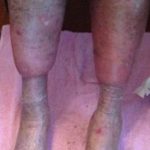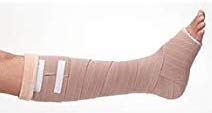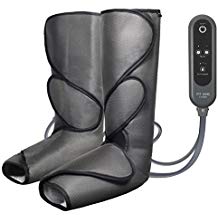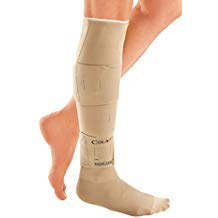The Importance of COMPRESSION in Wound Healing
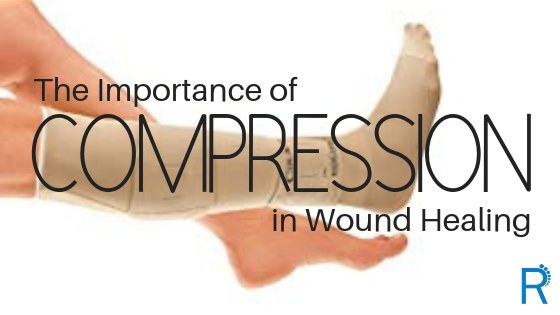
In those who have or treat chronic leg ulcers, few things evoke more reaction than the subject of compression: what type, how much, how often, over what primary dressing? But as clinicians, we understand two truths:
- Virtually no one is excited about wearing compression bandages or garments and
- Virtually everyone will need a compression strategy to get their wound healed and stay healed.
The patient’s perception on compression may be skewed by thinking it is just “tight socks” that will not be comfortable:
Or by experiencing compression that was just applied incorrectly:
Or perhaps they have tried their own compression “style” and it has not gone well:
Can’t the wound just be covered with one of those fancy patches to heal it? Isn’t there an ointment or a new wound product that can heal this leg ulcer without covering the whole lower leg? Aunt Betty had some honey that healed her wound. How about that?
What’s the big deal about compression and wound healing?
Whenever there is edema in the area, healing will be compromised. Acute edema can impair healing and should be controlled for the fastest repair of tissue (as with a sprained joint). Chronic edema leads to skin changes and often causes open ulcerations. The cause of the edema may be related to injury, inactivity, gravity, systemic fluid overload, or chronic venous insufficiency (CVI). Whatever the reason for the edema, it WILL impair healing through several mechanisms; including inhibiting fibroblasts (building blocks for new tissue), suppressing endothelial and epithelial cells, and accumulating cellular waste products. 1
Of all the reasons mentioned above for edema, the main culprit for venous leg ulcers is chronic venous insufficiency. This can be partially caused by impaired valves in the leg veins, causing venous reflux and venous hypertension. The other factor is poor calf muscle pump function. By inadequate calf muscle activity, the blood can pool in the lower leg instead of flowing up through the veins.2 Approximately 60% of the blood from the deep venous system is propelled toward the heart with the calf muscle pump activity.
Once edema is present in the lower leg with any of the above factors present, it takes very little for a wound to occur: a scratch, a bug bite, a bump of the leg, or skin damage from long term swelling and a wound is born. Now what?
COMPRESS: to press together
The type of compression to use for healing a wound is based on the individual patient with the wound. The very first thing to do is rule out any significant arterial disease, or poor blood flow. With an Ankle Brachial Index (ABI) of greater than 0.8, compression is the recommended treatment. Assuming that arterial insufficiency is ruled out, let us look at the types of compression.
Compression Bandaging: There are short stretch (inelastic) and multilayer long stretch (elastic) options for compression bandaging. Both offer very good results for healing venous leg ulcers. A recent review found no statistical difference between healing times of the two wraps.3 The choice of which bandage system to use is based on the activity level of the patient, the usual position of the patient, presence of other conditions (i.e. CHF, kidney disease, or lymphedema), and the experience of the practitioner.
- The short stretch has a higher “working pressure” activated when the person is using his/her calf muscle (i.e. exercising or walking).
- The long stretch sustains the applied pressure whether active or not.
- Both require skill of the practitioner to apply them, ensuring consistent stretch from the base of the toes to just below the knee for even compression. (Patients and families are generally NOT to apply these bandage systems.)
- Both allow for wound products to be placed directly on the wound to address drainage, bacterial load, or skin sensitivities. The wrap is then placed over these products.
- Both should be applied at a pressure gradient: the ankle should be a smaller diameter than the calf to allow the compression to work properly and propel the fluid toward the heart. Build up the leg circumference if needed with cotton or ABD pads to create the narrow to wide gradient required.
When choosing bandaging systems, consider the patient’s habits in conjunction with the treatment. If Mr. Jones spends all day sitting and then sleeps in his recliner, his legs will never get a break from gravity (as well as very little exercise to work the calf muscle pump). Investigate WHY he sleeps in a chair: does he have trouble breathing due to systemic conditions? Perhaps he can get a hospital bed to raise the head of the bed and yet still have his legs horizontal.
Does he have a difficult time getting into the bed? Refer to physical therapy for a home evaluation and functional training. Did his wife banish him to the couch? Well, perhaps that solution is a different department altogether.
COMPRESS: the process or result of becoming smaller
Sequential Compression Pumps: Intermittent pneumatic compression sleeves that are put on when a patient is lying supine with legs elevated slightly. The patient turns on the machine to pump for 30-60 minutes to reduce edema in a cycled compression/relaxation pattern. For the best results, a compression stocking would be put on after pumping.
COMPRESS: Condense or contract
Velcro Leggings: These are inelastic mesh materials that have multiple wide Velcro straps that are secured firmly from the ankle to the upper calf. There is usually a foot piece that is pulled on to just over the ankle. These can be removed and applied easier than compression stockings, but the downfall is that the Velcro is not pulled tightly enough to provide adequate compression. For the right patient, these can be very effective to reduce edema, especially for the maintenance compression once the wound is closed.
COMPRESS: To jam, crush, stuff, scrunch, smoosh, cram, or smash
(Experienced by all who have struggled to don compression stockings)
Compression Stockings: These can come in several styles and strengths and are generally recommended for the maintenance phase and prevention of edema. It is very difficult to heal an ulcer with compression stockings over a dressing for several reasons:
- The stocking can easily become compromised with drainage from the ulcer.
- The dressing over the ulcer will push against the stocking and stretch it out exactly where it is needed most once the dressing is removed or reduced, allowing the area to swell INTO the stocking that is now stretched out.
- Pulling a stocking on and off is difficult to do over a dressing and may create friction on the skin while donning/doffing the garment.
No matter where a wound is in its course of healing, edema will always create problems. The new wound will not begin to heal, the chronic wound will continue to stall, and the newly closed wound will be in danger of reopening if issues of local and systemic fluid are not noticed and managed. Please make sure you dress for success and compress!
This blog post was written by Robin Carlson, PT CWS
What is PT CWS? Physical Therapist and Certified Wound Specialist


